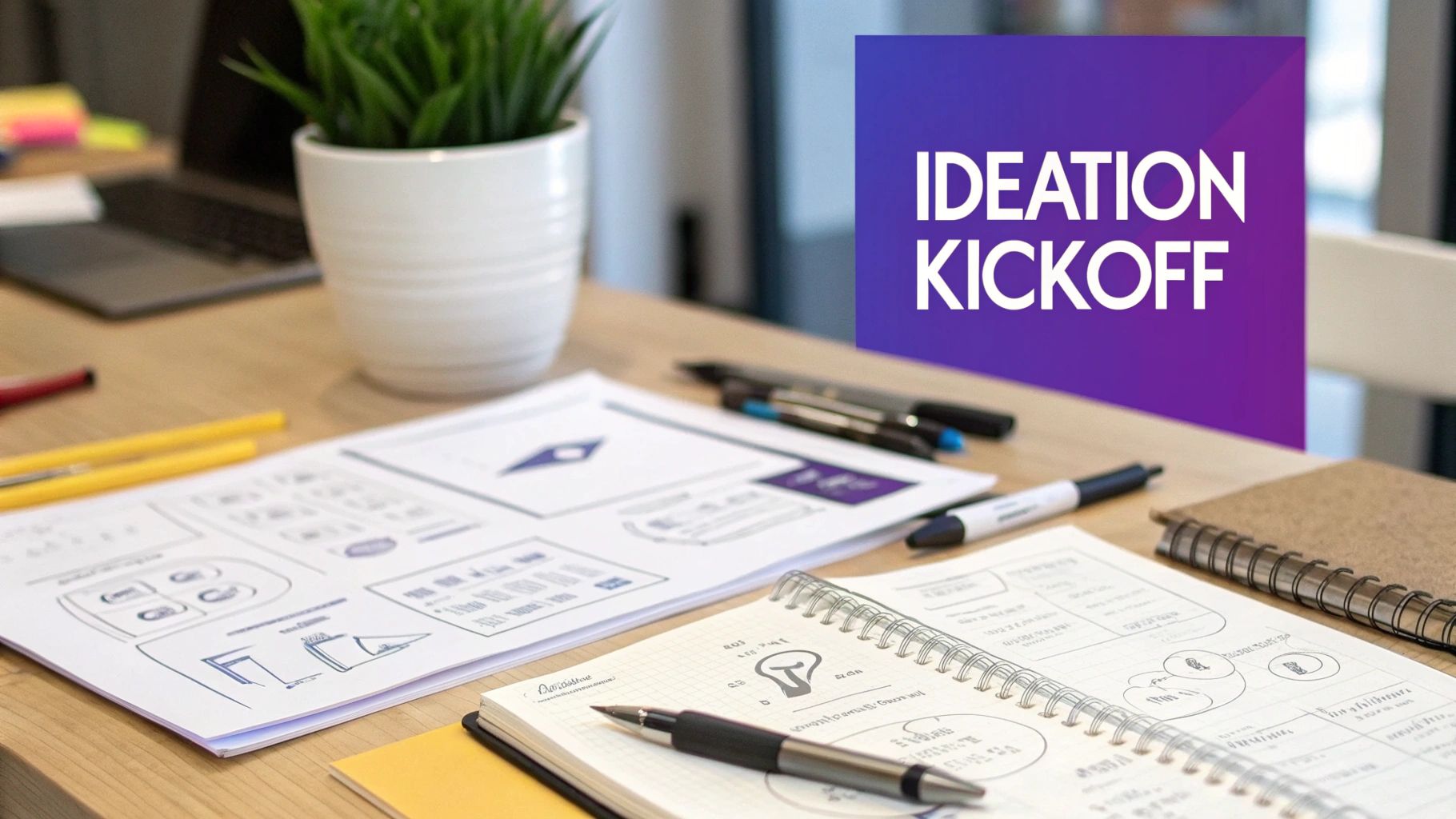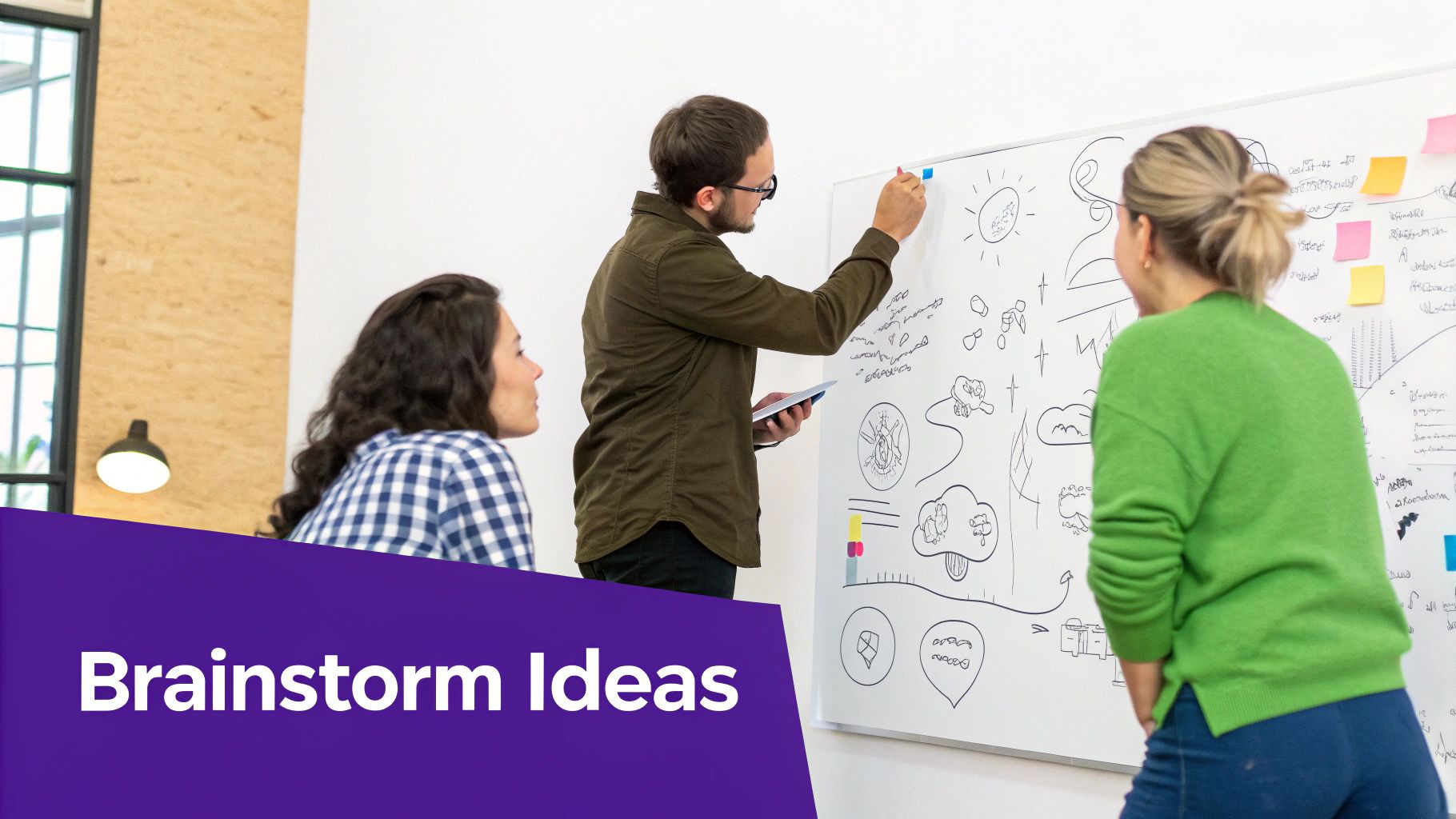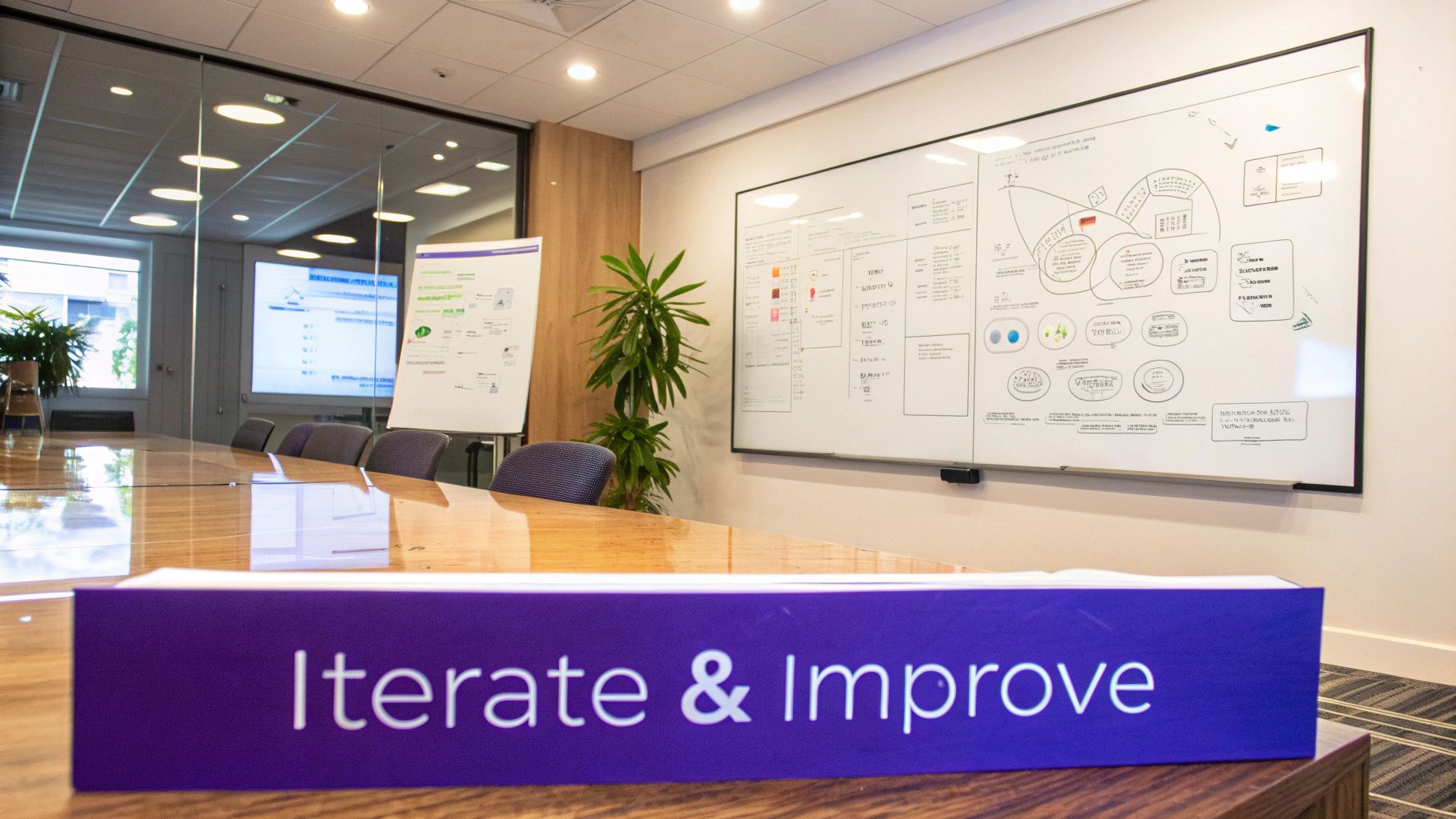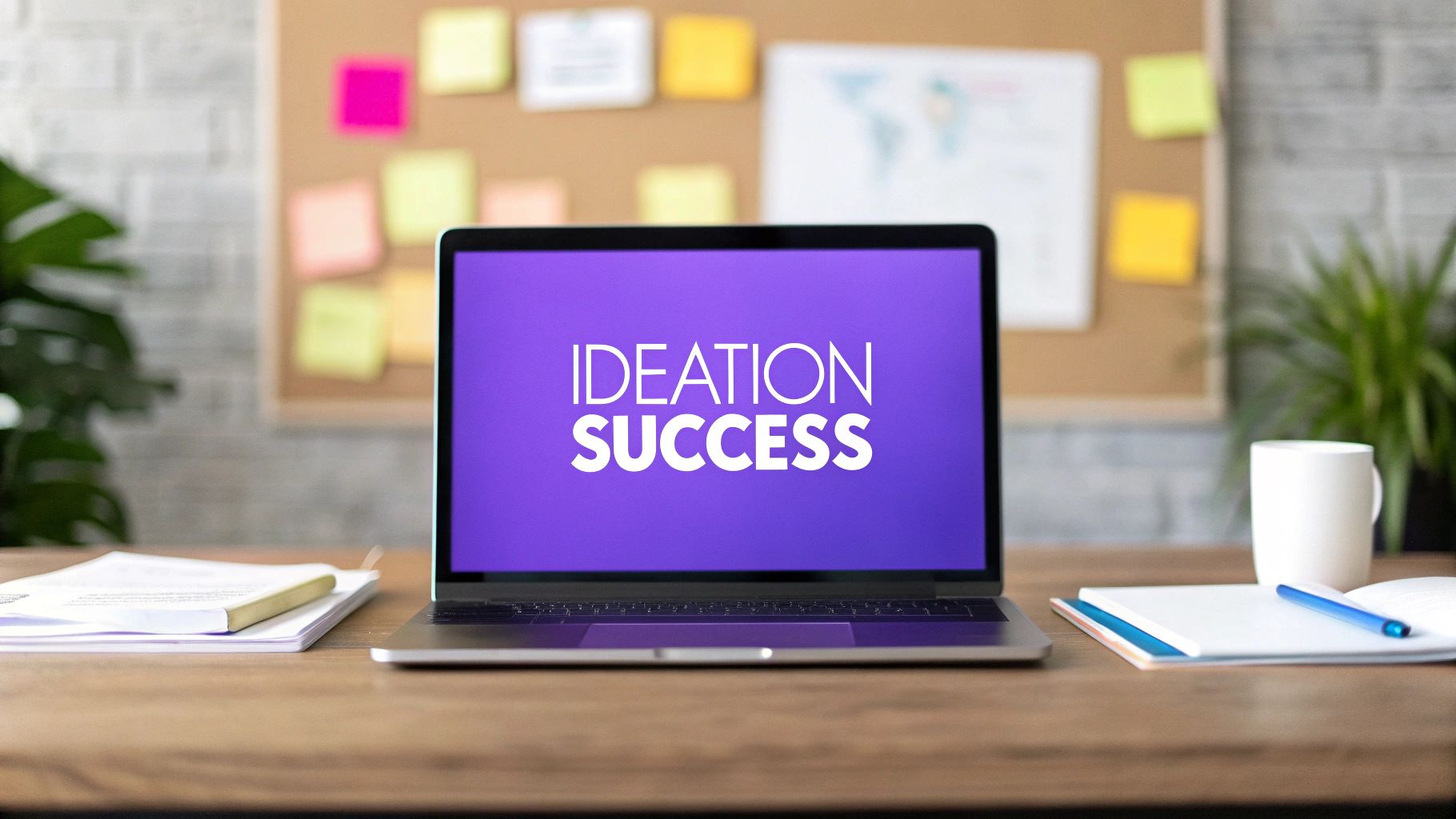The Evolution of Modern Ideation Frameworks

Ideation frameworks are now essential tools for successful innovation. They’ve grown beyond simple brainstorming, becoming structured systems that deliver real results. This growth is closely tied to broader design approaches, especially design thinking. This user-focused method, which emphasizes iterative and collaborative work, has greatly influenced how teams solve problems creatively.
For example, the design methods movement of the 1960s and 1970s established key principles still used in ideation frameworks today. By the early 2000s, design thinking was a central innovation strategy in many industries. Learn more about design thinking and its history: The History of Design Thinking.
From Brainstorming to Structured Ideation
Early ideation often relied on unstructured brainstorming. While this could generate many ideas, it often lacked direction and produced outputs that were hard to implement. The need for better methods led to structured ideation frameworks. These frameworks provide a clear path for the creative process, keeping teams focused while still encouraging innovative thinking.
The Rise of Outcome-Driven Approaches
The move to outcome-driven ideation is a major advance. This approach focuses on understanding customer needs before creating solutions. It ensures ideas are not only creative but also solve real problems, making them more likely to succeed. This customer-centric focus is increasingly vital in today’s competitive market.
The Role of Technology in Modern Ideation
Technology has also shaped how ideation frameworks work today. Tools like Bulby help remote teams with AI-powered guidance and exercises that streamline brainstorming. These platforms address the difficulties of distributed teams, making sure everyone contributes and building a collaborative environment.
This lets teams reach their creative potential, wherever they are. Integrating technology into ideation makes things more efficient, improves collaboration, and ultimately leads to better results. As the way we work changes, these technological advances will become even more important for successful ideation.
Core Elements That Make Ideation Frameworks Work
What makes one ideation framework generate brilliant ideas while another falls flat? It all comes down to the core components that drive its success. Effective frameworks find a sweet spot between open exploration and practical limitations, embracing diverse viewpoints while staying focused, and maintaining momentum from initial idea to final execution.
Balancing Creative Exploration and Practical Constraints
The best ideation frameworks don’t stifle creativity with rigid rules. Instead, they offer a structure that encourages exploration within set boundaries. Imagine a jazz improvisation: musicians have the freedom to express themselves within the song’s melody, harmony, and rhythm. Similarly, an ideation framework provides a structure for innovation. This balance ensures ideas are both creative and realistic.
Incorporating Diverse Perspectives and Maintaining Focus
Different perspectives are crucial for innovative solutions. A good framework welcomes input from various backgrounds. But too much divergence can lead to a scattered approach. The framework should focus these diverse perspectives onto the central challenge. This means clear goals and guidelines are necessary, while still encouraging a wide range of ideas.
Maintaining Momentum From Concept to Implementation
A good framework doesn’t stop at a list of ideas. It needs to help move from concept to action. This means establishing criteria for evaluating and prioritizing ideas, along with a clear development and testing process. This ensures the creative energy translates into tangible results. Check out this helpful resource: How to master product ideation.
To better understand the practical application of these core principles, let’s explore the key components of successful ideation frameworks in a comparative table. This table outlines the purpose of each component, the challenges in implementing them effectively, and the indicators of their successful implementation.
Introducing the table below, “Core Components of Ideation Frameworks,” we aim to provide a clear comparison of essential elements across different approaches. It’s important to understand both the purpose and potential hurdles of each component for successful implementation.
| Framework Component | Purpose | Implementation Challenges | Success Indicators |
|---|---|---|---|
| Clear Objectives | Define the focus and desired outcomes of the ideation process. | Ensuring alignment between objectives and organizational goals. | Increased idea relevance to business needs. |
| Structured Process | Provide a roadmap for generating and refining ideas. | Balancing structure with flexibility to avoid stifling creativity. | Improved efficiency and focus during ideation sessions. |
| Diverse Participation | Incorporate a variety of perspectives and expertise. | Overcoming communication barriers and facilitating inclusive participation. | Generation of a wider range of innovative ideas. |
| Evaluation Criteria | Establish standards for assessing and prioritizing ideas. | Defining objective metrics for evaluating subjective qualities like creativity and feasibility. | Selection of ideas with higher potential for success. |
| Implementation Plan | Outline steps for developing and testing selected ideas. | Securing resources and managing timelines for implementation. | Successful launch of new products or services based on generated ideas. |
As the table illustrates, each component plays a vital role. Clear objectives provide direction, while a structured process guides the ideation. Diverse participation brings in fresh perspectives, and evaluation criteria help prioritize the most promising ideas. Finally, a solid implementation plan ensures that these ideas come to fruition.
By incorporating these core elements, organizations can build ideation frameworks that consistently generate valuable and actionable results, leading to meaningful innovation.
Customer-First Ideation: Designing for Real Outcomes

Many ideation sessions prioritize idea quantity over quality. This often results in numerous concepts, but few have real market relevance. This can be a costly and inefficient approach. Instead, consider Customer-First Ideation.
This method focuses on understanding customer needs before exploring solutions. This ensures a targeted ideation process. It also creates ideas with significantly higher commercial viability.
One effective method of Customer-First Ideation is Outcome-Driven Innovation (ODI), developed by Strategyn. This framework emphasizes deep research into customer needs. The goal is to identify desired outcomes. These outcomes then guide the creation of meaningful solutions.
ODI has successfully helped create breakthrough products and services. It does this by directly addressing unmet customer needs. Strategyn’s process has been refined through hundreds of ideation sessions. These sessions often result in market-winning ideas in a single day. You can explore this topic further: Outcome-Driven Innovation Ideation Process.
Understanding the ODI Ideation Framework
ODI provides a structured framework. It centers around understanding customer goals. This differs from traditional methods. Those methods often jump straight into brainstorming solutions. They do this without a clear understanding of the problem. This crucial first step in ODI helps teams avoid wasted effort on ideas that don’t solve real customer problems.
Implementing Customer-First Ideation: A Step-by-Step Guide
Here’s how to implement a customer-first approach in your ideation sessions:
- Deep Dive into Customer Research: Start by thoroughly researching your target audience. This involves understanding their needs, pain points, and what they hope to achieve. Use surveys, interviews, and observational studies to gather detailed data.
- Articulate Desired Outcomes: Translate your research findings into clear statements. These statements should describe what customers want to achieve. These desired outcome statements should focus on the job-to-be-done, not specific solutions. For example, instead of “Customers need a faster computer,” a desired outcome statement would be “Customers want to complete tasks more efficiently.”
- Targeted Ideation Sessions: Use the desired outcome statements to guide your ideation sessions. Encourage your team to generate ideas that help customers achieve those outcomes. This focused approach leads to more relevant and impactful solutions.
- Prioritize and Refine: Evaluate ideas based on how well they address the desired outcomes. Prioritize the most promising concepts for development. Refine those ideas through prototyping and testing. This optimizes their effectiveness.
Measuring the Impact
Customer-First Ideation can greatly increase the commercial viability of your concepts. Some studies suggest an improvement of 3-5x compared to traditional brainstorming. This increase comes from focusing on real customer value.
By aligning your ideation efforts with customer needs, you increase your chances of creating successful products and services. You also minimize wasted resources. Instead of developing ideas that fail, you create solutions customers want. This helps your organization become more proactive. You can anticipate customer needs and develop innovative solutions.
Ideation Frameworks That Transform Education
The world of education is constantly changing. This requires new ways of thinking about learning and problem-solving. Ideation frameworks provide structure and flexibility for generating new ideas and addressing challenges in education. They help educators and students move beyond traditional brainstorming. This leads to more focused and productive creative processes. The goal is to move from simply identifying problems to developing practical solutions.
Ideation in the Classroom
Ideation frameworks are valuable tools for educators. They help cultivate critical thinking and problem-solving skills in students. For example, a teacher might use a design thinking framework to address a classroom challenge. Perhaps they want to improve how study materials are organized.
Students learn to empathize with different learning styles through this process. They define the core issue, brainstorm solutions, create prototypes, and test their ideas. This practical experience provides insights into real-world problem-solving.
Ideation frameworks also empower students. They become active participants in shaping their learning environment. By using structured ideation processes, they can identify areas for improvement. This could be in classroom activities, curriculum design, or even school policies. This encourages creative thinking and gives students a sense of ownership.
Institutional Ideation: Innovation at Scale
Ideation frameworks can drive innovation at an institutional level. Universities and colleges are using these frameworks to address complex challenges. These might include improving student retention or developing new research initiatives.
A structured ideation process helps institutions gather input. They hear from various stakeholders: faculty, staff, students, and alumni. This leads to targeted solutions tailored to their unique needs. Collaboration ensures that everyone’s voice is heard and solutions are practical.
Ideation frameworks also boost creativity and innovation among students. The Harvard i-lab, for example, promotes an ideation framework. It involves rapid prototyping and getting feedback from potential users. This process helps people understand the demand for new ideas. This happens before investing heavily in development. Focusing on user feedback early in the process allows for refinement based on real-world responses.
Cultivating Future Innovators
Integrating ideation frameworks into education has a significant benefit. It cultivates future innovators. By introducing these frameworks early, educators give students essential skills. These are skills for success in a rapidly changing world.
These skills include creative problem-solving, critical thinking, and collaboration. Students also learn how to adapt to new challenges. As they continue their education and enter the workforce, they will be ready. They’ll be prepared to tackle complex problems and develop innovative solutions in their chosen fields. This practical application makes ideation frameworks powerful. They prepare students for future success.
The Mentor Effect: Guiding Teams Through Ideation

While a solid ideation framework provides structure, the human element is still key. Mentorship plays a crucial role in guiding teams toward breakthrough innovation. Effective mentors help teams challenge assumptions, create safe spaces for sharing, and maintain momentum. They act as guides, facilitators, and encouragers, helping teams navigate creative problem-solving.
Fostering Psychological Safety for Ideation
A key benefit of mentorship during ideation is the creation of psychological safety. This safe environment lets team members express themselves freely, without fear of judgment. When individuals feel comfortable sharing, even unconventional thoughts, ideation becomes richer and more productive. This open communication is vital for exploring a wide range of ideas and pushing boundaries.
Challenging Assumptions and Expanding Perspectives
Mentors also help teams challenge assumptions and broaden perspectives. They bring valuable experience and knowledge, offering insights that might be overlooked. This external perspective helps teams avoid getting stuck in old ways of thinking and encourages them to consider new approaches. This is especially important in fast-paced environments where familiar solutions can hinder innovation.
For example, a mentor might encourage a team to explore a problem from a customer’s point of view, even if the team mainly consists of engineers. This shift in focus can reveal unmet needs and spark innovative solutions. You might be interested in: How to master remote teamwork. This outside viewpoint helps teams break free from existing assumptions and create more customer-centric solutions.
Maintaining Momentum and Driving Results
Another important aspect of mentorship is maintaining momentum. Mentors help teams stay focused on objectives, overcome roadblocks, and ensure actionable results. This guidance helps teams stay on track and avoid getting bogged down by complexities or disagreements. This is essential for turning ideas into tangible outcomes.
This focus on practical application extends to academia. In higher education, mentoring is closely tied to ideation and innovation, particularly in research. Mentoring helps students navigate complex research environments and improve their performance. Discover more about the importance of mentorship in academic settings here. This guidance helps bridge the gap between theory and practice.
Building Effective Mentor-Mentee Relationships
Effective mentorship requires strong mentor-mentee relationships built on trust, open communication, and shared goals. Organizations can identify and develop mentors through training programs and initiatives. This ensures mentors are equipped to support teams effectively.
When these supportive relationships are combined with a well-defined ideation framework, the potential for innovation increases significantly. This combination of structure and guidance helps teams navigate the ideation process more successfully, leading to more effective solutions and faster progress.
Measuring What Matters in Ideation Success
How do you know if your ideation framework is truly effective? Simply generating a high volume of ideas isn’t enough. This section explores how to measure the real value of your ideation efforts, shifting the focus from quantity to the quality, feasibility, and ultimate impact of the ideas generated.
Beyond Idea Quantity: Assessing Quality and Feasibility
While a large number of ideas may seem impressive at first glance, it’s the inherent quality of those ideas that truly drives success. A well-designed ideation framework should produce ideas that are not only creative but also practically feasible and aligned with core business objectives. This means establishing clear criteria for evaluating the quality of each idea.
These criteria might include factors like potential market size, the technical feasibility of development, and alignment with the company’s overall strategic direction. Assessing the feasibility of implementing each idea is also critical. An idea can be brilliant on paper but impossible to execute due to practical constraints.
Considering factors like resource requirements, existing technology limitations, and potential regulatory hurdles is essential to determine whether an idea can be realistically implemented.
Measuring Business Impact: Demonstrating Value
The ultimate measure of any ideation framework lies in the positive impact it has on the business. This impact can manifest in various ways, such as increased revenue, reduced operational costs, improvements in customer satisfaction, or the successful expansion into new markets.
Tracking relevant key performance indicators (KPIs) is vital for demonstrating the tangible value generated by your ideation framework. For instance, if a new product idea emerges from your ideation process, tracking metrics like sales figures, customer reviews, and market share growth can help you assess its real-world impact.
Establishing KPIs and Feedback Loops for Continuous Improvement
To accurately measure ideation success, leading organizations define clear KPIs from the very beginning. These KPIs should adhere to the SMART principle, meaning they are specific, measurable, achievable, relevant, and time-bound. This approach enables objective measurement and ensures alignment between the ideation process and overall organizational goals.
Establishing robust feedback loops is another key component of continuous improvement. Regularly gathering feedback from participants in the ideation process, as well as from stakeholders impacted by the resulting ideas, can uncover areas for improvement within the framework itself.
This feedback might lead to refining the ideation process, adjusting evaluation criteria, or providing additional training to facilitators. The resulting insights are then used to enhance the framework’s effectiveness over time.
To illustrate these concepts, the following table provides examples of performance metrics for evaluating the effectiveness of an ideation framework.
To get a better understanding of how to evaluate your ideation framework, let’s look at the table below. It outlines some key metrics you can use to track your progress and identify areas for improvement.
| Metric Category | Specific Measures | Collection Methods | Interpretation Guidelines |
|---|---|---|---|
| Idea Quality | Originality, customer value, market potential | Surveys, expert reviews, market analysis tools | Higher scores suggest greater potential for innovation and market success. |
| Implementation Feasibility | Resource requirements, technical feasibility, timeline | Internal assessments, expert consultations | Lower resource needs and shorter timelines generally indicate higher feasibility. |
| Business Impact | Revenue growth, cost reduction, customer satisfaction | Sales data, cost analysis, customer surveys | Positive changes in these metrics demonstrate a positive business impact from implemented ideas. |
By focusing on these critical metrics, organizations gain valuable insights into the performance of their ideation framework. This data-driven approach facilitates more strategic decision-making, ensuring that ideation efforts contribute meaningfully to the overall success of the business.
Your Ideation Framework Implementation Roadmap

Turning an ideation framework concept into a practical tool requires a solid implementation roadmap. This section provides a step-by-step guide for choosing, adapting, and implementing a framework tailored to your specific innovation goals. We’ll explore how successful organizations move from theory to practice, building a system that encourages creativity and delivers tangible results.
Assessing Current Capabilities and Identifying Opportunities
The first step is to honestly evaluate your organization’s current ideation practices. What are your strengths and weaknesses? What processes are already in place, and how effective are they? Pinpointing areas for improvement is essential for selecting the appropriate framework.
This self-assessment creates a benchmark for measuring future progress. It also highlights where a new framework can make the biggest difference.
For instance, if your team struggles to generate diverse ideas, a framework that emphasizes varied perspectives might be beneficial. If the challenge lies in execution, a framework focused on prototyping and testing might be more suitable.
Selecting and Adapting Your Ideation Framework
Once you understand your needs, you can start exploring different ideation frameworks. The five-stage design thinking process is a great starting point. Our guide on essential innovation process steps provides further insights.
There’s no one-size-fits-all framework. Adapting a framework to your specific needs is often crucial. This might involve tweaking certain elements or combining aspects of multiple frameworks.
Customization ensures the framework aligns with your company culture, resources, and objectives. The goal is to create a system that works for your team. Experiment and iterate until you find the right fit.
Deployment and Stakeholder Buy-In
Successfully launching a new ideation framework requires buy-in from key stakeholders. This involves clearly communicating the framework’s benefits and how it will improve innovation. Training for facilitators and participants is also vital.
Effective training empowers individuals with the skills and knowledge to use the framework effectively. Cultivating a supportive atmosphere where team members feel comfortable sharing ideas is crucial for fostering creativity. This psychological safety encourages open contribution without fear of judgment, leading to a richer and more productive ideation process.
Scaling and Continuous Improvement
Implementing an ideation framework is an ongoing journey. It demands continuous monitoring and improvement. As your organization’s innovation capabilities grow, you may need to scale your framework.
Regularly assessing the framework’s effectiveness and gathering participant feedback helps identify areas for refinement. This iterative process ensures the framework remains relevant and continues to deliver value. By tracking progress and making adjustments, you can optimize your ideation process and create a culture of continuous innovation.
Ready to boost your team’s brainstorming sessions? Bulby, the AI-powered brainstorming platform designed for remote teams, can help you implement your ideation framework and unlock breakthrough innovation. Visit Bulby today!

